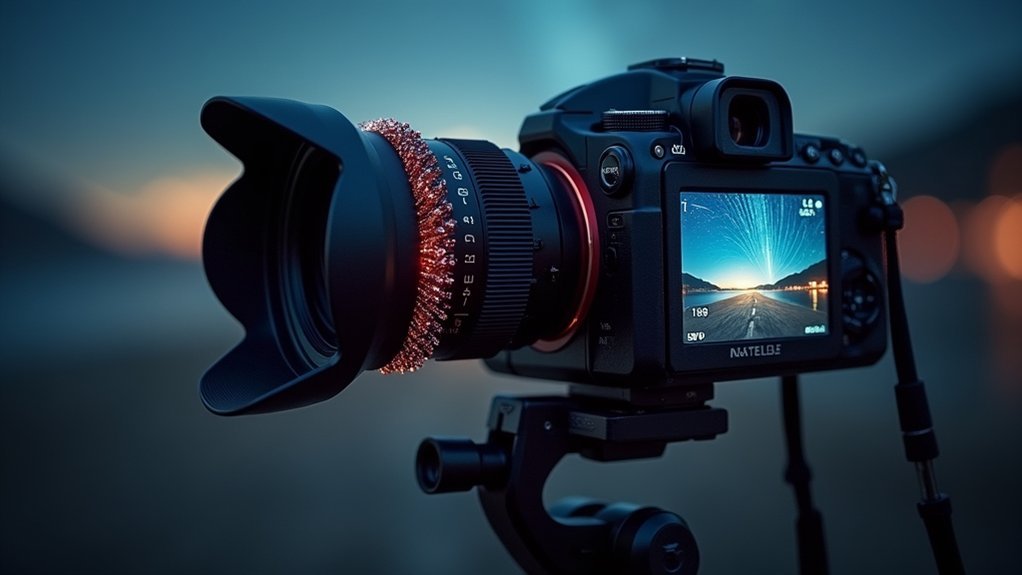To cool your camera sensor effectively, turn off the LCD screen, use an external battery pack, and take cooling breaks between exposures. For better results, try a DIY Peltier cooling system that can drop temperatures by 6-10°C. Keep ISO settings low and implement dithering between frames. Always monitor temperature to prevent condensation, using silica gel packets and proper insulation. These techniques will dramatically reduce noise in your long exposures. Discover how much cleaner your night sky images can become.
Passive Cooling Solutions for DSLR Sensors

While digital cameras continue to advance in resolution and features, they’re also generating more heat that can degrade image quality.
During long exposure photography, thermal noise becomes especially problematic as your camera’s sensor heats up over extended exposure times.
You can combat this by allowing your camera to reach ambient temperature before shooting.
Turn off the LCD screen during operation—this simple step greatly reduces heat generation.
For more effective passive cooling, consider using external dummy batteries that keep heat-producing components outside your camera body.
Create a DIY heat sink by attaching small metal fins to non-essential parts of your camera, or build an insulated cooling box that maintains lower temperatures.
These passive cooling techniques help maintain image quality without requiring power-hungry active cooling systems, particularly beneficial for astrophotography sessions.
Building a DIY Peltier Cooling System on a Budget
For photographers seeking more dramatic temperature reduction than passive methods provide, a DIY Peltier cooling system offers an affordable active solution.
Using a thermoelectric cooler (TEC), you can reduce sensor temperatures by 6-10°C, noticeably cutting read noise during long exposures in low light conditions.
Start with a basic TEC element paired with a heat sink to dissipate heat from the hot side.
Add a small fan to improve airflow, keeping the ambient temp around the heat sink lower.
Use wooden partitions for insulation to prevent damaging condensation on electronic components.
Power your active cooling system with a 12V battery delivering at least 1A.
Always monitor sensor temperature to prevent frost formation—maintain it above freezing for peak performance without risking damage to your camera’s delicate components.
Heat Management Between Long Exposure Sequences

Despite having effective cooling systems, you’ll still need strategic heat management between long exposure sequences to maximize image quality.
Keep your camera sensor at consistent temperatures by implementing 10-20 second exposures with 5-10 second cooling breaks between shots. This prevents excessive heat buildup that increases dark current and exposure noise.
Lower ISO settings generate less heat while dithering between frames helps maintain cooler operating temperatures.
Remember that calibration frames should match your light frame temperatures exactly—even with a cooled camera, temperature consistency matters more than absolute coldness.
For best results in hot conditions, accumulate a significant number of sub-exposures (100+) to effectively average out thermal noise.
This methodical approach to heat management delivers cleaner final images with superior detail and less processing headaches.
Preventing Condensation During Extended Cooling
When cooling your camera sensor for astrophotography, condensation becomes your primary enemy. To prevent moisture from compromising your light-capturing capabilities, maintain sensor temperature above freezing but below the dew point—a sweet spot around 6-8°C offers ideal performance without risking frost formation.
Properly insulating your cooling system creates an essential barrier against heat exchange with ambient air. Place silica gel packets in airtight compartments near the back of the camera to absorb excess moisture.
Monitor your setup throughout the night, as temperature fluctuations require ongoing adjustments to your cooling strategy.
Installing small circulation fans helps maintain even temperatures across your equipment, preventing localized cold spots where condensation might form.
Remember that effective moisture management is just as important as the cooling itself for capturing those crisp, detail-rich astronomical images.
Measuring and Monitoring Sensor Temperature Reduction

Accurate temperature measurement forms the backbone of effective sensor cooling in astrophotography. When you’re tracking the decrease in temperature, you’re fundamentally monitoring the effectiveness of your cooling methods.
A properly cooled sensor (ambient -9°C) versus an uncooled one (ambient +10°C) can show a remarkable 20°C difference, dramatically reducing thermal noise in long exposures.
- Use dedicated temperature monitoring devices to guarantee your sensor remains above freezing
- Track temperature consistency between calibration frames for ideal noise reduction
- Measure the differential between ambient and sensor temperature to evaluate cooling efficiency
- Monitor continuously during extended sessions to prevent condensation and frost formation
Frequently Asked Questions
How Do I Cool a Camera Down?
You can cool your camera by turning off the LCD screen, using external power, adding fans or cooling systems, letting it acclimate to ambient temperature, and ensuring good airflow around the device.
Do You Need a Cooled Camera for Astrophotography?
No, you don’t need a cooled camera for astrophotography. While cooling reduces noise during long exposures, you can achieve great results with uncooled DSLRs by using proper exposure techniques and noise reduction methods.
What Is a Cooled Camera?
A cooled camera uses specialized technology to reduce your sensor’s temperature during operation. You’ll find it has a built-in cooling system that minimizes thermal noise, giving you cleaner long-exposure images, especially for astrophotography.
What Does a Camera Sensor See Without a Lens?
Without a lens, your camera sensor sees an unfocused, blurry image. It’ll capture light intensity and colors, but you’ll miss all detail and clarity since there’s nothing to properly direct light onto the sensor.
In Summary
You’ve now got multiple options for cooling your camera sensor. Whether you’re using simple passive methods, building a DIY Peltier system, managing heat between exposures, or preventing condensation, the key is consistent temperature monitoring. For astrophotography and long exposures, even a few degrees reduction can dramatically improve your results. Implement these techniques, and you’ll see noticeably less noise in your nighttime images.





Leave a Reply